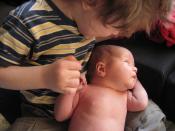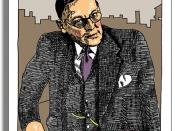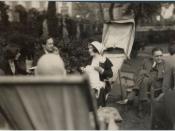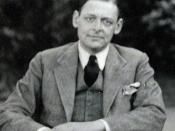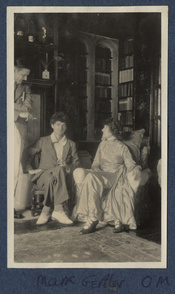Facts There is something that the 2ÃÂnd president of the United States, John Adams, the 19ÃÂth president, Rutherford B. Hayes, and William de Aliot, one of the conquerors of Hastings all had in common. They were all related to the distinguished poet Thomas Strearns Eliot. Thomas Stearns Eliot was born on the 26ÃÂth of September, 1888 in St. Louis as the seventh child of Henry Ware Eliot and Charlotte Eliot. His place of birth was a large, two-story late Victorian house. There were several servants employed here - a cook, a second maid, a nurse, a laundress, a gardener, and others. Being raised in a household of people much older than himself, he felt ìrather overwhelmedî by his family. At his birth, his parents were already in their forties and had been married for twenty years. Stearns was his motherÃÂs maiden name. Thomas Stearns Eliot was born with a congenital double hernia and because of this had to wear a truss for most of his life.
He received endless care from six sisters and mother. T. S. Eliot came from a very distinguished family. His grandfather was a devoted preacher who in 1834 moved to St. Louis from Boston to ìsave the souls of the people living in this land lacking conscience.î He helped to found Washington University, Smith Academy, a boysàschool and later, Mary Institute, a school for girls. William Eliot was the dominant presence in the household even though he had died one year before ThomasÃÂs birth. Even in old age, T.S. Eliot remembered his influence as that of one who ìrules his son and his sonÃÂs sons from the grave.î In 1906 at the age of 18, T. S. Eliot began studies at Harvard University, concentrating on literature and philosophy. At the age of 24, Eliot wrote his first major works, ìPreludesî, ìPrufrockî, ìPortrait of a Ladyî, and ìLa Figlia che Piangeî. The next year, Eliot was awarded a traveling scholarship from Harvard and completed them in England. He decided to remain in England to avoid being drafted into WW1, but in 1917, he returned to the US and tried unsuccessfully to enlist in the Army and also the Navy. In addition to being a poet, Eliot was a bank clerk, teacher, and assistant editor of the literary magazine The Egotist. He also founded The Criterion, another literary magazine. As a poet, critic, dramatist, and editor, Thomas Stearns Eliot was a major innovator in modern English Poetry. He is most famous for his revolutionary poem, ìThe Waste Land.î He helped to usher in literary modernism by stressing tradition, continuity, and objective discipline. Ezra Pound was an inspiration and a mentor to T. S. After meeting in 1914, the two became good friends. In 1921 when Eliot wrote ìThe Hollow Menî, probably one of his most celebrated works, Ezra was the first person whom he showed. In fact, Eliot even had some of his best works edited by Pound. The two continued their friendship until ThomasÃÂs death in 1965. Some of his awards include the Dial award, won for ìThe Waste Landî (1922), the Nobel Prize for Literature (1948), the British Order of Merit (1948), and the American Medal of Freedon posthumously. In 1915 at the age of 27, Eliot married Vivienne Haigh-Wood. In the beginning, he was content with his marriage, but eventually VivienneÃÂs mental instability led to her confinement in a mental institution for the last 17 years of her life. The emotional difficulties produced by the marriage prompted some intense passages in EliotÃÂs poetry. ìAsh-Wednesdayî, published in 1930. Many critics have interpreted this poem to contain references to EliotÃÂs marriage. One of them is as follows: ìLady of silences Calm and distressed Torn and most whole Rose of memory Rose of forgetfulness Exhausted and life-giving Worried reposefulî Family ThomasÃÂs father, Henry Ware Eliot was a successful business man. He was already growing deaf when his son was born and there is a sense in which Thomas never seemed to have felt close to his father. Later in life Eliot had felt that he had let his father down, that he had left him unhappy and bewildered with the course of his own life. His mother, Charlotte Champe Eliot had an immediate influence on his life. Her influence never left him and she made sure that it did not. Her ambition and care for him was constant because they sprang from her own sense of failure. She had left school and never went on to higher education in spite of the fact that she desperately wanted to. She had once told her son that she considered herself ìa dead failure due to the fact that she never attended college.î She wrote poems to friends or as contributions to newspapers and pasted them into scrapbooks. She received no early recognition and her own frustration with her literary gift was channeled into ambition for that of her son. According to a relative, Charlotte was not ëparticularly interested in babiesàand she had no real relationship with Thomas throughout his infancy. Once this stage had passed and Thomas began to exhibit signs of intelligence, his mother showed him her love and introduced him to literature. Thomas was genuinely devoted to his mother and continued to keep in touch with her until her death. His parents both influenced his poetry. His father drew cats and the mother wrote poems on themes of prophecy and martyrdom. Thomas himself wrote a series of poem dealing with cats and martyrs. ìThe Naming of Catsî and ìThe Waste Landî are two such examples. As a child, Eliot was an avid bird-watcher and continued this activity throughout most of his life. Every summer, the family would stay in a cottage in Goucester, Massachusetts. The ocean always inspired him, and although most of his poems did not reflect the sea, it was one of his favorite places to think. --------------------------------------------------------------------------- (essay2) The above essay was an oral report. It is not formatted to be handed in to a teacher. Rather, it was notes I used while making a presentation to my Sophomore Honors English Class. (I got a 98 out of 100) Back to start
